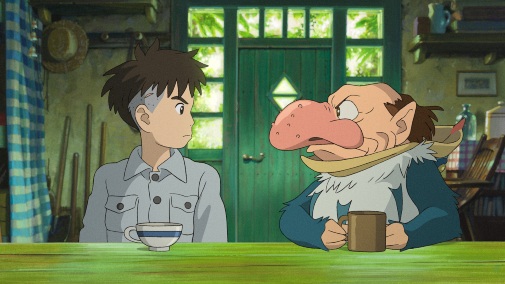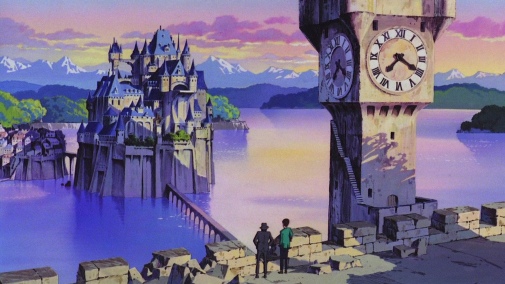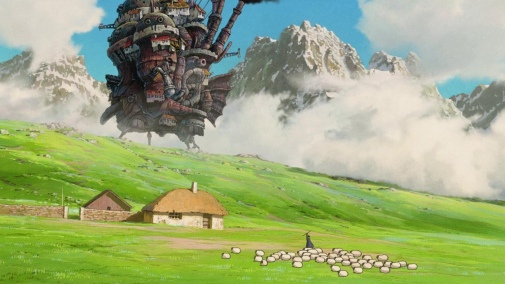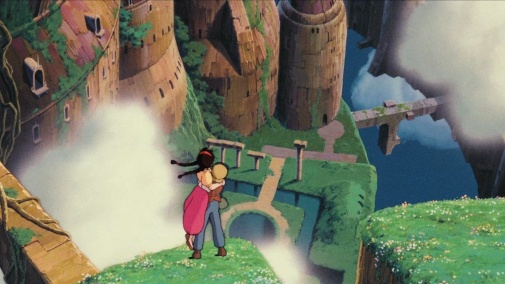My Miyazaki Ranking: Part One - CastleMania
 Friday, March 22, 2024 at 8:00PM
Friday, March 22, 2024 at 8:00PM 
After its triumph on Oscar night, The Boy and the Heron is returning to cinemas all over the world. To commemorate this theatrical re-release and start closing my chapter of the 2023 film year, I took this opportunity to review Hayao Miyazaki's entire oeuvre. And so, we find ourselves standing before one of the greatest filmographies in the medium's history - animated or otherwise - ready to rank the master's twelve features. I'd love to share my thoughts on Miyazaki's shorts, but sadly, most of them are exclusively shown at the Ghibli Park and Museum. Maybe someday I'll be able to witness their beauty - one can dream.
From times when Studio Ghibli was naught but a dream to its twilight years, spanning half a dozen retirements and the loss of countless colleagues, Miyazaki's gift to cinema is a sprawling wonder. This shall be my personal ranking, not definitive by any means as it's a love letter, an expression of the utmost awe. Ask me in a week, and I'll order the films differently. Today, this is how I see them…
Because this article grew so much through research and re-watches, I divided it into four parts, each covering three films. This first batch is curiously castle-bound as far as titles are concerned.

12. LUPIN III: THE CASTLE OF CAGLIOSTRO (1979)
Everyone has to start somewhere. For Hayao Miyazaki, that somewhere was Toei Animation and the when was 1963. Within the studio, he worked on several projects, ranging from TV serials to features like 1968's The Great Adventure of Horus, Prince of the Sun, for which he was chief animator and scene designer. That film's director, Isao Takahata, would become Miyazaki's lifelong friend and creative partner, and it was with him that he left Toei in the early seventies. The two worked on various endeavors, including a litany of episodes for the Lupin III anime, adapting the popular manga by Katō Kazuhiko.
A product of TMS Entertainment, the series grew in popularity throughout the decade, prompting the company to invest in new seasons and the occasional feature release amidst the show's airing. The Castle of Cagliostro was the second of such films and the first that Miyazaki got to direct as a transplant from the franchise's TV side. By this point in his career, he had already established a certain name for himself through his many Takahata collaborations and Future Boy Conan, a series that, to many, represents the earliest example of what could be called a Miyazaki masterpiece. In any case, it was a much more personal project than Cagliostro would come to be.
Essentially, Miyazaki's first feature found him working as a hired hand, deferent to an established brand and storytelling ethos. What I mean is that if you're yearning for the director's specificities as a storyteller and audiovisual artist, you might be better off looking elsewhere. That doesn't mean The Castle of Cagliostro is some meritless hackwork, of course. Still, there are some touches worthy of analysis here and there. For example, I understand Miyazaki softened its titular thief a great deal, conveying his particular vision of the character rather than the sharper edges he possesses in other media.
Whatever the case, the slapstick comedy doesn't always work, especially when it's not centered around the protagonist, and for every striking frame, there is a multitude of others where the limits of a TV budget taken to the big screen become difficult to ignore. It's a lot of fun, bouncy, and energetic, perfectly entertaining as an adventure but not an auteur film by any means, even as some characteristics of future Miyazaki shine through. Notice how the backdrops already suggest the pan-European aesthetic that would pop up in later works by the yet inexistent Ghibli.

11. HOWL'S MOVING CASTLE (2004)
Like Cagliostro, Howl's Moving Castle feels a tad impersonal within Miyazaki's oeuvre. Part of that feeling certainly stems from its production history, which didn't start with its final director in mind. Instead, this Diana Wynne Jones adaptation was supposed to be helmed by Mamoru Hosoda. Back in 2001, when this project had its genesis, he was most known for the Digimon anime, but nowadays, you're more likely to recognize his name from films like Mirai and Belle. If Howl had developed as planned, it'd be the first Ghibli feature not directed by one of its founders or an animator fostered in its ranks. But, in the end, Hosoda's approach proved ill-fitting for the studio, and he quit.
That event left everything in disarray, inevitably leading to Miyazaki's involvement, much like he had done years before with Kiki's Delivery Service. Unfortunately, his take-over wasn't as successful and the picture bears the scars of a dysfunctional adaptation. The big issue is the script, which falls into repetition in a few passages and sprints through others at such a dizzying pace that the sense of contrivance can't be helped. Many of the characters feel aimlessly erratic, and with the titular role left so nebulous, it's hard to connect emotionally with his struggle.
Miyazaki's attempts to shape Wynne Jones' story into an anti-war narrative as his response to America's doings in the Middle East (ostensibly the reason why he skipped the 75th Academy Awards) are heartfelt in fits and starts. At points, the story forgets that purpose altogether, which isn't helped by the director's lifelong struggle to articulate his love for flying machines of war while hating their reason for existing. However, many grace notes can be found in Howl's Moving Castle, including the gorgeous steampunk building itself – only possible thanks to mixing traditional techniques with computerized innovation.
Indeed, the whole thing is gorgeous to behold, making for the pinnacle of Miyazaki's predilection for a pseudo-European aesthetic. The music by Joe Hisaishi is similarly ravishing, putting forward the picture as a spectacle above all else. That said, I fear I'm being too harsh. After all, the director's gentle Humanism blossoms within the convoluted fantasy, mostly when meditating on the plight of a young soul trapped within an old body. As its heroine, Sophie Hatter is her film's most engaging element, even when the romantic plotting of her arc proves an unsteady match for the director.

10. CASTLE IN THE SKY (1986)
Miyazaki's first feature to be made under the banner of Studio Ghibli, Castle in the Sky is an essential historical mark fated to be forever overshadowed by the two films bookending it in the chronology of its director's career. It's neither as influential as Nausicäa nor as iconic as Totoro, stuck in their shadow despite its many merits. That's not to say subsequent productions didn't borrow from it. Check out Disney's Atlantis: The Lost Empire if you want to be confronted with many of the same concepts in service of a lesser story with a much different ethos underpinning what we see on screen, shining crystal-like.
In a way, Castle in the Sky represents the full blossoming of the auteur's style and preoccupations, a Rosetta Stone summarizing everything from his attachment to Western architecture as an exotic other to the ecological concerns at the heart of so many narratives. There is also moral ambiguity despite an adherence to the convention of adventure flicks. It's materialized chiefly in the titular structure, ready to settle in the thoughts of viewers who'll carry Miyazaki's ideas of complicated progress beyond the screening room. And, of course, it's an audiovisual spectacle of the highest formal excellence.
The picture affirms itself a miracle of animation from the moment aircrafts cut through clouds like pirate ships on a celestial ocean and a girl falls from the heavens. And it only gets better from there. Even the title sequence is extraordinary, replicating the effect of wood-cut prints. Then, there's the fairytale vision of a miner society directly inspired by the director's observations of Wales in the aftermath of the 1984 Miners Strike. Try to stop yourself from feeling awe when the animated sun peeks into the village valley, and faraway birds fly between shadow and light. I sure can't help but be astonished. Even better, that's way before the Laputian kingdom uncovers a ghost Eden.
Of all Miyazaki features, this was the one I remembered the least about before re-watching, leading me to believe it was forgettable. But then, while basking in its glory, I realize many of its images have been forged into my mind, haunting dreams since I first encountered it in childhood. Watching it again was a flurry of déjà vu mixed with the warmth of re-encountering a long-lost friend. It's breathtakingly beautiful at times, serving its industry and commercial needs as a proof of concept for Studio Ghibli. "Here's what those maverick filmmakers can do, elevated to the pinnacle of perfection. This is what anime can be!"
The Castle of Cagliostro is streaming on Hoopla, while the other two films are on Max. You can also find all three on most major platforms, available to rent and purchase.



Reader Comments (5)
Here's what I've seen from Miyazaki so far from my list that includes an obscure short he did in the early 1970s that I saw on MUBI. I would love to go head-on into his body of work as I'm happy to know it's coming to Netflix as I hope to get access to Netflix within a few months.
I really need to find time to be a completist with Miyazaki. I've seen everything from Princess Mononoke onward but didn't ever get around to the earlier films.
I know so many people whose favorite Miyazaki movie is Howl’s Moving Castle that it’s honestly a relief to see someone else rank it towards the bottom of his filmography. I thought I was alone in thinking that. Still a good movie, but you’re right, it doesn’t feel nearly as personal or deep as most of his other works.
Genuinely startled that Castle in the Sky couldn't make the top half. When forced to choose, it's my favourite.
Can't wait to hear your thoughts on the rest.
thevoid99 -- YUKI'S SUN is more like a sizzle reel/pitch for an anime series that was never made. It's still Miyazaki's first solo director's credit, though, so it has great historical importance in retrospect.
NATHANIEL R -- I think you'll enjoy some of those. At least, I hope you do, since I love so many of them.
Edwin -- I have the same experience. I know many folks who rank it as their favorite Studio Ghibli title.
Arkaan -- It's a wonderful film, just not one of my favorites. Honestly, the top ten all represent great works of cinema, and I understand loving each and every one.